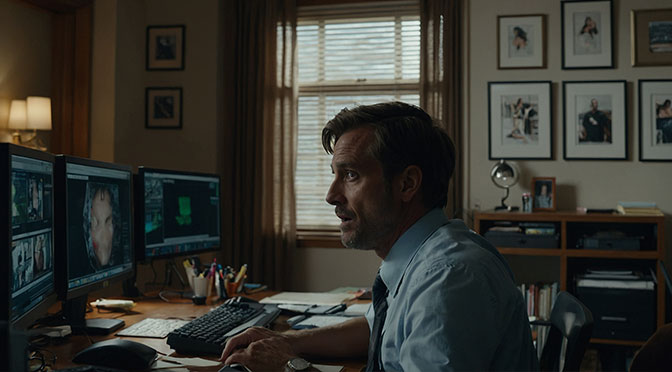The fascination with the concealed gaze threads through literary history like a crimson filament—from the furtive observations in medieval poetry to the sophisticated direction of perception in modernist works. In our digital age, this ancient motif undergoes a remarkable transformation, opening an intriguing field of tension for emerging authors of erotic literature: the intersection of voyeurism with the possibilities afforded by modern technology.
Reinterpreting the Hidden Gaze
In classical erotic literature, the voyeuristic gaze typically manifested through physical barriers—a keyhole, a crack in the door, a hidden refuge behind heavy curtains. The digital dimension expands this repertoire with a crucial component: the apparent invisibility of the observer, who is no longer connected to the object of desire through spatial proximity, but through technological linkage.
Remote access to foreign systems—whether through trojans, spyware, or other digital tools—creates a narrative situation where the traditional parameters of voyeurism are redefined. The focus shifts from physical concealment to penetration of digital privacy, raising deeper questions about intimacy, control, and vulnerability.
The Interplay of Distance and Immersion
What makes the connection between technology and voyeuristic narrative perspective so distinctive is the paradoxical simultaneity of distance and proximity. The observer exists at a physical remove that can transcend geographical boundaries—the ocean between protagonists becomes a trivial detail. Yet simultaneously, technology enables an intimacy of observation that surpasses even the traditional keyhole in its immediacy.
Consider this narrative situation: A character gains access to the webcam of someone with whom they share a complex emotional connection. The physical distance becomes a literary tool that intensifies emotional tension, while the digital proximity creates a new form of intimacy that can be both disturbing and captivating.
This duality can be leveraged literarily to explore various levels of perception. The author can alternate between the observer’s physical reality (their space, their bodily reactions) and the observed subject’s digital reality, creating a fragmented yet intense narrative rhythm.
The Ethical Dimension as a Narrative Element
The ethical ambivalence of this scenario doesn’t impede literary exploration—quite the contrary, it provides fertile ground for complex character development. The moral gray area in which the observing protagonist operates can serve as a catalyst for internal conflicts that extend far beyond superficial erotic tension.
An author exploring this terrain faces the challenge of finding balance between depicting transgressive actions and developing psychological depth in their characters. Questions of consent, power, and the psychological motives behind the urge for concealed observation can lend the story a multidimensionality that transcends the purely sensual.
Crafting Authentic Technical Components
The credibility of a narrative centered on technologically enabled voyeurism depends significantly on convincing portrayal of technical aspects. This doesn’t mean the author must complete a course in cybersecurity, but rather develop a sense for the right balance between technical detail and literary effect.
Instead of getting lost in technical jargon, the focus can be placed on technology’s impacts—the sudden awakening of a screen in a dark room, the quiet hum of a hard drive storing foreign secrets, or the uncomfortable familiarity with the habits of someone unaware of their digital companionship.
Technology thus becomes not an end in itself, but a medium enabling new forms of encounter, power, and vulnerability. A skilled author avoids both excessive technical exposition and naive simplifications, concentrating instead on the human aspects of this technologically mediated intimacy.
Digital Space as a Stage for Self-Revelation
A particularly interesting dimension emerges from the fact that people often reveal sides of themselves in digital spaces that they conceal in physical space. The protagonist who gains access to foreign digital spheres witnesses not only intimate physical moments but also intimate psychological states—whether through observing private searches, personal messages, or uncensored self-expression.
This multilayered exposure—both physical and psychological—offers the author an opportunity to connect erotic tension with emotional depth. The voyeuristic gaze captures not just the body but also the hidden thoughts, desires, and fears of the observed person, leading to a complex intertwining of physical and psychological intimacy.
The Author’s Responsibility
The literary exploration of digital voyeurism opens fascinating narrative possibilities that go far beyond superficial arousal. It allows engagement with fundamental questions about privacy, intimacy, and the boundaries between connection and intrusion in an increasingly networked world.
As an author in this genre, one faces the challenge of combining erotic tension with psychological depth, ethical reflection, and technological credibility. The goal isn’t to provide technical instructions, but to explore human experience in a world where the boundaries between public and private, between proximity and distance, between observing and participating increasingly blur.
Successful literary treatment of this theme isn’t characterized by the mere portrayal of transgressive scenarios, but by sensitive and complex illumination of human longings, fears, and contradictions revealed in these digital reflections.

